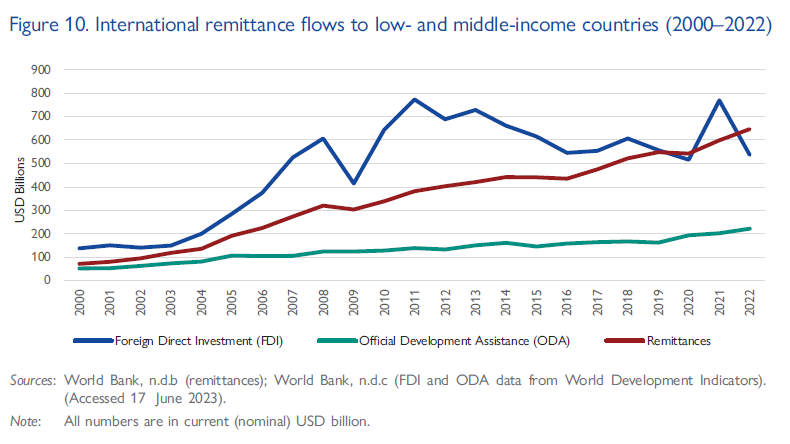Migration and Development
Migration and development
Migration is a major driver of human development globally. Migrants and diaspora communities contribute to the delivery of the sustainable development goals more than any other group of state and non-state actors.
In 2015, all 193 Member States of the United Nations adopted the 2030 Agenda for Sustainable Development — a plan of action for people, planet and prosperity. Complete with 17 Sustainable Development Goals (SDGs), the agenda is a commitment by countries, non-governmental organisations, businesses, scientists, farmers, and other actors to act to eradicate poverty, strengthen universal peace, and protect the planet.
Safe and regular migration pathways are central to growth and prosperity, with migrants an important part of the solution for reaching the sustainable development goals. Migration contributes to all 17 Sustainable Development Goals (SDGs), and in particular to poverty reduction (Goal 1: No poverty); increased innovation and entrepreneurship (Goal 9: Industry, innovation and infrastructure); and investment in businesses and human capital (Goal 8: Decent work and economic growth). Migrant remittances also finance sustainable development and reduce inequalities (Goal 10: reduced inequalities).
See the interactive scenario in this module to “spin the SDG wheel” to explore how each SDG relates to migration and learn more about migration-relevant data for sustainable development.
Labour migration: increased innovation, entrepreneurship and human capital
Many economies around the world need migration to support economic growth, including by filling available jobs and skills gaps (known as labour market shortages), for example in the construction industry, food sector and care work. Migration is a real necessity, especially in countries with declining and ageing populations. A recent study showed that every additional 1% of immigration can boost the economy (specifically Gross Domestic Product) in destination countries by 2% (see IOM video).
Migrants provide a source of dynamism globally and are well represented in entrepreneurship, innovation, patents, the arts and science awards, start-ups, and successful companies. 36% of high-tech companies are founded by migrants, including Google, eBay and Intel. The immigration of young workers can also help ease pressures on the pension systems of high-income countries.
Diasporas and development
Diaspora communities can contribute to the development of their countries of origin in three ways: sending money and goods (known as remittances) back to family and communities in countries of origin; through diaspora bonds; and through diaspora networks and migrants who return home.
International remittances are financial or in-kind transfers made by migrants directly to families or communities in their countries of origin, which are often used to meet basic household needs, such as food and shelter but also education, health services and start-ups. They help reduce poverty, inequalities and work towards other SDGs.
Remittances have increased significantly over time, rising from an estimated $128 billion in 2000 to reach around $831 billion in 2022. The flows to low- and middle-income countries have trended up to reach around $650 billion, despite the closure of borders during the COVID-19 pandemic, which blocked migration for many. While they have long outpaced official development assistance, remittances now also outstrip foreign direct investment in low- and middle-income countries, as shown in the figure below.

From WMR 2024, Ch. 2
Diaspora bondsare another key way migrants contribute to the development of their countries of origin. They allow countries to raise necessary funds among diaspora communities, such as after disasters, whilst avoiding accumulating debt from expensive lenders. Migrants also enhance economic development and productivity in their home countries through [foreign direct investments and the creation of new businesses.**(https://www.oecd-ilibrary.org/development/perspectives-on-global-development-2017/the-development-impact-of-migration-in-origin-countries_persp_glob_dev-2017-11-en)
Diaspora networks and communities can facilitate trade, investment and cultural exchange between countries of origin and destination. They can also act as advocates for development and better governance in their home countries, influencing policies, reforms and mobilising resources for development projects. When migrants return home, they can contribute “brain gain,” whereby migrants bring back new skills, knowledge and innovations acquired abroad. Networks of highly skilled migrants often foster collaborations and knowledge exchange between countries of origin and destination. Research shows that migrants who return to their country of origin are more likely to start businesses than are people who never left their countries (OECD, 2016).
Migrants bring with them new ideas, values and practices, sometimes referred to as ”social remittances.” These types of remittances are transferred or exchanged in various ways, including when migrants return to live in or visit their communities of origin, when non-migrants visit those in the receiving country, or through the exchange of letters, videos, cassettes, emails, blog posts and telephone calls. Importantly, not all social remittances are positive. The ideas and practices that migrants bring with them can have both positive and negative effects. For example, migrants have helped to shape gender norms in countries of origin by supporting and arguing for greater gender equity after experiencing it in other countries. Returning migrants have been found to have contributed positively to the empowerment of women and girls in their home countries. However, those who migrated to countries with lower ratings of gender equality tend to bring back more conservative gender norms.
For a more detailed discussion on migrant contributions to the socio-cultural, civic-political and economic areas of society, see module Migrants’ Contributions.
Key resources on the topic
Global Overview ([WMR 2024, Ch. 2])
Regional Developments (WMR 2024, Ch. 3)
Migrants´ contributions (WMR 2020, Ch. 5)
Growing Migration Inequality (WMR 2024, Ch. 4)
A Post-Pandemic Rebound? (WMR 2024, Ch. 9)
Reflection questions
Which sustainable development goals (SDGs) does migration contribute to? Outline the different ways migration contribute to SDGs 1, 8, 9 and 10.
How does labour migration support the economic growth of destination countries?
Fill in the blanks from the text: % of high-tech companies are founded by migrants, including , , and .
Can you think of any other companies in your own communities that have been founded by migrants or refugees?
Discuss three ways diaspora communities can contribute to the development of their countries of origin.